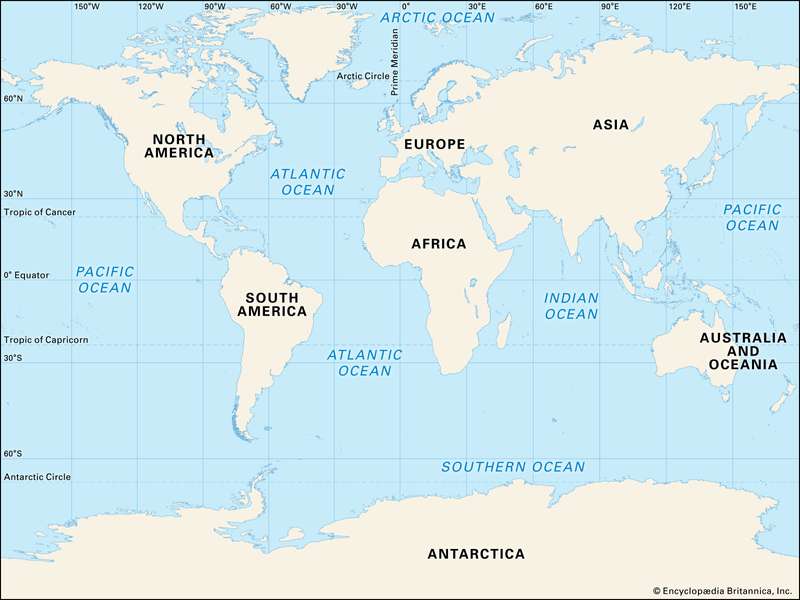General knowledge portals and nature books are destined for an update. For, this Ocean day, June 8, to an existing list 4 oceans namely Atlantic, Indian, Arctic and Pacific, premier map making body National Geographic Society (USA), added a fifth. Newly inducted Southern Ocean is a formal recognition of what was in existence by the name of Antarctic Ocean.
Road to 5th Ocean
The most widely accepted theory regarding the origin of earth as we know it is that in the beginning there was only one Ocean named ‘Oceanus’ and one Super-continent known as ‘Pangaea’ before the continental drift slowly broke apart the landmass and the world as we know now began taking shape. The oceans we know today were recognised and named by geographers and cartographers over a century ago.
The International Hydrographic Organisation (IHO) along with United Nations is responsible for border survey and naming of navigable water bodies. The group globally acknowledged the Southern Ocean in 1837, comprehensive research took off in 1928, and a proposal for formal recognition was drafted in 2000. But the lack of consensus about specified boundary prevented the formal recognition of the erstwhile South Pacific Ocean. Out of the IHO’s 94 members few raised their reservations about exact borders. Decision was stalled since then.
Now, Nat Geo has updated its map policy on their website and this ocean will be reflected on new maps. Alex Tait, National Geographic Society Geographer said that “The Southern Ocean has long been recognized by scientists, but because there was never an agreement internationally, we never officially recognized it.”
According to Nat Geo their purpose of recognising it as separate body is “to shed light on the region’s conservation needs and grow the scientific research opportunities.”

What’s so unique about it?
Dr. Suyash Kumar, Professor and Head at Geology Department, Government Science College, Gwalior told The Voices, “All the oceans on the earth were made at different time periods. Southern Ocean was formed around only 30 million years ago when Antarctica and South Africa drifted from each other. Hence geologically it is the youngest of all the Oceans”
Southern Ocean is the icy water surrounding Antarctica which encompass a unique marine ecosystem. The reason for the distinct ecology of this ocean is the Antarctic Circumpolar Current (ACC) which carriers colder and less brackish water compared to water north of it. This is the only ocean which is bordered by three other oceans and is yet not the extension of them due to the ACC.

According to Dr. Suyash “The main reason behind the ecological richness of the ocean is that waters circling Antarctica are very cold and they move northwards and come in contact with relatively hot waters. That maintains a balance in temperature creating the booming biodiversity of this ocean”
He further added “The adverse effects of climate change are highly noticeable in Antarctica region and in recent past the ozone hole over the Antarctica has had adverse effects on the ecosystem of these waters”
The ocean also stores 35% of global carbon uptake from atmosphere and 75% of global oceanic heat. With the change in climate and rapid increase in human activity in Antarctica, the Southern Ocean is vital for scientific studies. World’s largest marine protected area- The Ross Sea is a part of Southern Ocean formed to protect the nutrient-rich waters which are the habitat of krill, plankton, penguins, whales and many more species.
When asked what might be the effects of glacier caps melting on the marine life of the waters Dr. Suyash said “The rise in sea-level due to melting of glacier caps won’t have that big of an effect in change of its biodiversity compared to difference in temperature and salinity due to global warming which effect the life of flora and fauna of the waters. Due to these differences some new species may develop, some old one’s might evolve and some species may go extinct”
Road ahead: IHO yet to respond
Most of the countries take 60 degrees south latitude as its north border excluding the Scotia Sea and Drake Passage.
The U.S. Board of Geographic Names had approved the name “Southern Ocean” back in 1999 and The National Oceanic and Atmospheric Administration (NOAA) is in accordance with National Geographic society’s decisions.
Even though the IHO has still not commented upon this official announcement by National Geographic, from now onwards along with Nat Geo, other map publishers such as Hema Maps and GeoNova will also be including Southern Ocean in their maps.
Edited by: Raghujit .S. Randhawa



1 Comment
Informative article…Nice to read..